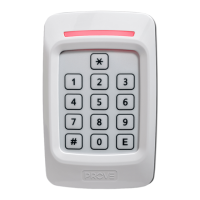
Do you have a question about the Nidac 2 Series and is the answer not in the manual?
| Brand | Nidac |
|---|---|
| Model | 2 Series |
| Category | Card Reader |
| Language | English |
Enables/disables automatic re-locking of the ELC relay after door opening.
Warns if a door remains open beyond a set time limit, activating DOTL output.
Detects if a door is opened without a valid access code or EGRESS activation.
Locks out codes for 1 minute after 5 successive invalid entries.
Configures the PAC2 to operate using one or multiple user codes for access.
Illustrates fundamental wiring connections for the Presco keypad to the PAC2 decoder.
Describes the audible and visual feedback provided by the keypad during programming.
Procedure to erase all programmed user codes from the system memory.
Restores the PAC2 to factory default settings, clearing all configurations.
Step-by-step guide for initial configuration of the PAC2 access controller.
Configuration for the automatic relock function via memory setting 80.
Setting for the EGRESS input switch type (Normally Open/Closed) via memory 81.
Configuration of the ELC relay output type (N.O./N.C.) via memory 82.
Sets the duration the ELC relay remains active for door release via memory 83.
Enables or disables the door switch input for monitoring door status via memory 84.
Configures the time limit for door open before a DOTL alarm via memory 85.
Enables or disables door forced open detection via memory 86.
Configures the 1-minute lockout after invalid code attempts via memory 87.
Selects the user code operating mode (single, dual, etc.) via memory 88.
Sets the time interval for entering two sequential codes via memory 89.
Procedure for programming, changing, or deleting the management code.
Details on programming, managing, and using user access codes.
Step-by-step guide for adding new user access codes to the system.
Method for altering the operating mode of an existing user code (momentary/toggle).
Instructions for removing existing user access codes from the system.
